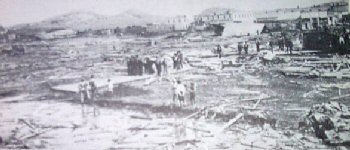
This article appeared in the Snyder Signal-Star a couple of days after the tornado that destroyed Snyder OK, May 10, 1905, and gives a first hand view of the damages and death. The copy of this article was transcribed by Mrs. Ina Bryan Staggs, granddaughter of William Riley Bryan, from the Signal-Star, about 1973, and submitted to this site by Curtis Bryan, a descendent of the William Riley Bryan family and nephew of Mrs. Staggs, that homesteaded 6 miles southwest of the future town of Snyder, OK.
The Snyder Signal Star
May 12, 1905
In large headlines: Most Terrible Storm. Snyder in Ruins – More Than a Hundred Dead – Another Hundred Wounded. Worse Than War – Which Is Hell. Heart Rending Incidents – Hundreds Homeless. The Most Deadly Storm Known to the West. Articles Carried Fifty Miles in Track Of Storm.
Were you ever in a cyclone? If you have had such an experience you will believe the story of the storm without question. If you have not, you will be inclined to say it is all bosh. But the following report contains nothing which the editor does not know to be true. The truth is horrible enough without enlarging on it and no one wants to picture it worse than it is. Wednesday the 10th of May, 1905 was the day. The hour was between 8:00 and 9:00, several watches having stopped showing from 14 to 18 minutes before 9:00 it is safe to say that the town was wiped out about 8:45.
Heavy clouds had been hanging in the southwest for some time, but they were high and presented no threatening appearance – people freely expressing opinions as to whether or not a rain would come. A few minutes before 8:00 a fearful roaring was heard in the southwest. The writer remarked to his family that “but two things ever cause a roar like that – either a very heavy hail storm or a cyclone”. A few minutes of the fearful roaring, and then came a heavy rainfall accompanied by some hail. This caused a second remark expressing belief that we were then getting the outer edge of a heavy hailstorm which had visited Greer County. In a few minutes the rain ceased and was succeeded by the most terrific electrical storm the writer ever witnessed. Electricity ran along the telephone wires with hissing like a sky rocket starting its upward flight. This lasted probably another fifteen minutes, ceasing as suddenly as it started. Then, after a moment’s dead lull, the hungry monster broke upon the town picking up strong and well built buildings and tossing them about like they were bundles of straw – taking away the fragments of one man’s house and leaving in it’s place pieces of houses which stood blocks away.

The storm struck the town a little north of the southwest corner of town and lifted everything west of Main and damaging Main Street buildings by sucking front and back ends of the buildings. From 6th Street north, every building in the town was claimed by the storm. Not a building north of the railroad was left. The ten-stall brick roundhouse and the two cotton gins joined the debris which was carried on the wings of the wind. To the writer it seemed as if the work of destruction continued a full ten minutes, but of course it was a shorter time. It may have been a minute; it may have been three – no one can say for a certainty, but in the time whole families were slaughtered and every dollar’s worth of property, save the ground, was swept out of existence.
When the spared people crept out of the caves or came from the houses which had not been claimed by the wrath of the wind, they stood for a moment dazed and stunned. Frantic appeals for help and pitiful moans of the dying fell upon dulled ears for an instant, and then the town awoke to the necessity of action and the work of rescue began.
Soon the dead and wounded were being carried into available rooms, but later the rescue work was devoted alone to the living, and this work continued throughout the night. “Oh for daylight” was the plaint of many burdened hearts as they sought for loved ones, and the air was filled with cries welling up from hearts filled with anguish when the lifeless forms of dear ones were found. The Pritchard and the Peckham buildings were in a few minutes filled with the injured and the dead. Both living and dead were horrible in appearance. Clothing had been torn into rags or completely from the forms. Through the slimy black mud which covered every face it was almost impossible to recognize features. This made the work of identification very difficult, and most of the identifications were arrived at through recognition of some article on the persons.
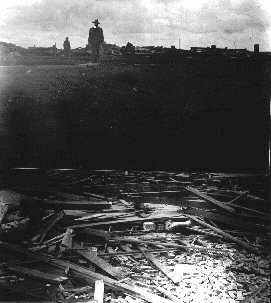
Soon the search for loved ones was transferred to the rooms temporarily turned into morgues and hospitals. Oh, the agony of it all. The uninjured searching for some lost one – the pitiful inquiries made by injured ones for those that were with them when the storm struck, and their appeals for further search to be made. Men who had not shed a tear for ten years cried like children – there was no effort to conceal the tears which forced themselves into the eyes of those whose desire to assist forced them to look upon the awful sights to be seen on every side. Pen can never describe the horror of it all so that those who have not passed through similar trials can arrive at one tenth part of the awfulness of the suffering of the injured and appearance of the dead.
Soon after the storm had lulled the building in which the Chinese Laundry was located, and which had been heaped in a pile by the wind, was found to be burning. A strong north wind was carrying fire brands to the business houses left standing, and a heroic fight was made to prevent a general conflagration. Luckily the gutters were so full of water that water enough was secured to put the fire out. It had to be fought by inches – the crackling flames rolling and pitching as if jealous of the havoc the wind had made in so short a time. A fire also broke out in the partially destroyed Worsham building, but quick work overcame it and the Woodard, Tennison & Hoffmaster and Wey buildings were saved from the general destruction.
Daylight came – and permitted a view of the destruction wrought. Where hundreds of dwellings had stood when the sun went down, not an upright stick had remained, and an open prairie greeted the eye. As was said before, the ruin was complete from where the storm struck the town a little north of the school house and on the west line of town through to the northeast part of town. It mowed a swath from five to seven blocks wide. Nothing which stood in the path of the storm, and many buildings which were not in the path were wrecked. Not a building was standing which does not show some of the storms work. Not a person who was in the direct path of the storm escaped serious injury or death, save those who took refuge in storm caves or cellars, Not a horse, cow or pig escaped – all fell victim to the greedy storm.
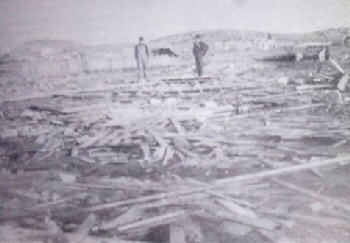
The work of rescue was resumed as soon as daybreak, the injured being cared for first and the dead then gathered up and hauled to the morgue by wagon loads. It was a gruesome sight, and yet men and women who would ordinarily shrink at the sight of blood and suffering with set features stoically went about doing the best they could for whoever needed help. A large room was established in a large room at the west side of the Hilton building, and all wounded conveyed there who had not through the night been taken to some private residence. The Tennison & Hoffmaster building was taken as a morgue and very soon the floor of the 50x80 building was crowded with the remains of men, women and children. The sight was appalling and only the awfulness of the occasion gave men strength to properly care for the bodies. Every stitch of clothing which had not been torn off, and every part of the person exposed were simply solidly cemented with a slime of black mud. The clothing was removed; the poor mangled remains as nearly cleaned as they could be, and each body wrapped in muslin to await final burial. The shelves and counters were filled with these, reminding one of the stories of old Catacombs where tier above tier of bodies are to be seen.
Volunteers were called for to dig graves and make coffins, and though many responded not much headway was made the first day toward burying the dead. Soon after the storm S. B. Odell walked to Mountain Park and gave the alarm – but he talked so daffy as did everyone who went through the storm, that people wouldn’t believe him. He had been followed by Edgar L. Bealle and Fred C. Sweitzer and when they too told the story of the awful calamity the town was aroused and every man able to get here came over and assisted our people in the work of rescue and such other work as was needed. The writer with others was fighting the fire when a party of men came up and said “We are here to help and others are coming.” It was the first of the kindly feeling which soon came to us from all surrounding towns and their promptness will always be treasured in the memory of those who met that first party.
When Sweitzer and Bealle succeeded in arousing the Mountain Park operator to the needs of the hour the news of the calamity out speeded the storm, and all towns within reach began making up special trains. The train from Hobart which arrived between 4:00 and 4:30 a.m. bringing 75 men and women, several doctors among them, were the first to reach here, and no party received a more heartfelt welcome than they did. It was not evidenced by a noisy demonstration, but by silent pressure of the hand – and tearful expressions of gratitude. Following the Hobart train special trains arrived every few minutes. And our people soon realized the disaster “made all people kin” – that everybody within reach of us was our friend. Soon cars loaded with needed supplies for hospital and homeless began to arrive.
By 11:00 Thursday morning a mass meeting was called for the purpose of organization. A General Relief Committee consisting of E. P. Downen, B. C. Burnett, G. J. Helena, Fred C. Sweitzer and W. M. Allison was elected – and E. P. Downen made chairman, G. J. Helena Treasurer and B. C. Burnett secretary. On the ground a subscription for relief was started and considerable money subscribed by gentleman who were present at the meeting. Thus was the relief work put under organization. The world was notified that supplies of all kinds and cash were needed, and request made that all remittance and shipments be addressed to G. J. Helena, Treasurer.
A quartermaster department and under it a commissary department were established and everything put in shape to carefully take care of everything that came in, and the needs of those that were homeless. Everything was systemized and is at this writing running smoothly and in a satisfactory manner... The general committee has divided the work between them so that each member is in direct charge of a certain department of the needed work. E. P. Downen has charge of the supplies; G. J. Helena the finance; Fred C. Sweitzer the rebuilding; B. C. Burnett cleaning streets and town of debris and dead animals and W. M. Allison of the hospital.
Hundreds of ladies have come in and offered their services as nurses to the sick. Many have served as long as they could and then given away to others who were anxious and willing to assist. Snyder owes these noble ladies a debt of gratitude which can never be amply repaid.
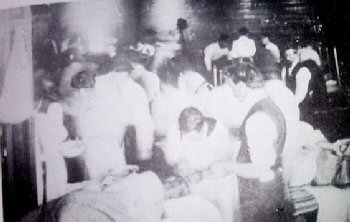
List of the Identified Dead
| Mr./Mrs. J.P. Sutherland | Mr./Mrs. George Davis, 1 child |
| Mr./Mrs. C.L. Hibbard, 2 children | Mr./Mrs.Hibbard, parents of C. L. |
| 2 McCart children | Henry Orcutt |
| J. W. Hudson, 4 children | Mrs. Laura Russell |
| Mrs. Attoway, 2 children | Mr./Mrs. S.S. Fessenden, 11 family members |
| Mrs. Belle Stubblefield | Miss Moody |
| Mrs. Coleman, 3 children | Mrs. T. E. Davis |
| Miss Pearl Taylor | Mrs. Jack Hunter |
| C.C. Paulson | Mrs. E. L. Beckwith |
| Mr./Mrs. W. H. Buser, son Russell | Fred Crump |
| George W. Bailey | C. W Beeman, son Earl |
| Harrold Gorton | Mrs. M. A. Fost |
| Mrs. Cal Williamson | 3 Crook Children |
| Florence Baker | W. O. Engles |
| Ray Moss | Mabel Engles |
| Mrs. Mary Biggs | Charlotte Engles |
| C. L. Barnes | W. A. Martin |
| Miss Henderson | Miss Murphy |
| Mrs. Martha Lawson | Charles Stutzel |
| Albert Orchard | Mr./Mrs. A. D. Sims, 2 children |
| Pearl Staley | Fanny Redwitch |
| Mr./Mrs.G. C. Jones, children | Van Buskirk |
| Miss Julia M. Edwards | Mary Johnson, son |
| C. G. Donovan | W. B. Smook's baby |
| Mary Mize | Mrs. W. H. Stubblefield, child |
It is almost impossible to give a full list of the injured as many who were not badly hurt have left town or are going about, and others who are in serious condition are cared for in private homes in town and surrounding farms.
List of Injured
| Mr/Mrs. M. A. Crooks | Judge B. W. Logan |
| Florence Coleman | Mrs. Perry Griffin |
| Mrs. J. F. Attoway | Florence Holmes |
| Mr./Mrs. W. B. Snook, son Van | Mr. Wyrick |
| Joe Millard | Alice Dunn |
| Sam Lee | Hudson boy |
| George Carson | J. W. McCart, daughter |
| Bluke Hall | W.V. Willingham |
| Mrs. C. C. Paulson | -------Pitzer |
| C. L. Beckwith | Little Eugh girl |
| R. Beckwith | Miss Hudson |
| John Craner | Mrs. Kenny Peyton |
| Mr./Mrs. J. H. Sigler | J. W. Egan |
| Ed Harrison | Kenney Peyton |
| Miss Ruby Sutherland | Jim Bishop |
| Thomas W. Kidd | Mrs. Hackett |
| Mrs. George W. Bailey | Miss Gearhart |
| Grace Buser | Mrs. W. R. Downy |
| Myrtle Moss | J. J. Ferguson |
| Mrs. R. K. Moss | Sam Montgomery |
| Freedom Buser | Dr./Mrs. Muller |
| John Lawson |
It is impossible to give anything like a complete list of the wounded, but the number will reach far above that of the dead.
On Friday two heavy rainstorms came and as the roof had been partly torn from the building in which the hospital had been opened, it looked for a time as if the sufferers would all be drowned. But speedy work by many willing hands saved them and they were removed to another room in the same building. This room was too small and Dr. Borders, who had been installed as head surgeon, insisted on a better room. As none could be found, which had escaped injury, a roof was put back over the first room by a gang of volunteers. A partition was run, an operating room built and drug room arranged, and the patients all returned to the room SUnday morning. They are now as comforably situated as they can be made under all the circumstances. Doctors from other towns and scores of of ladies and gentlemen have from time to time taken their turn as watches and nurses and the wounded are bing cared for.
Sunday 100 men came down from Hobart, organized into ten companies with a Captain over each. These men will ever hold the admiration of Snyder. Monday a party from Eldorado and some from other points returned, and good work toward clearing up debris and burning animal carcasses was accomplished. THe Territorial Engineering Corps under the command of Captain King have been valuable assistants in maintaining orderand clearing up.They too will ever be dear to Snyder. The town will be rebuilt. The work of restoring buildings has already begun, and though it will take the town some time to fully recover its old appearance and activity, it will it will certainly do so.
At this writing no sort of list of destroyed property can be made. Later we will try to give it as well as a detailed statement of all contributions received and expenditures made by the committee.
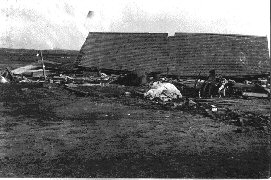
Anything belonging to Van BusKirk, please leave at Illinois House, Snyder, Oklahoma. Fifty dollars reward will be paid for return of square theatrical trunk with name Catherine Winters stenciled on one end. Or proportionate reward will be paid for return of any of the articles carried off in the trunk, leave at this office.
It would take a paper equal in size to the St. Louis and Kansas City Sunday papers to tell all the story and give full particulars. So much was crowded into the two minutes of horror and the results were so far reaching that it would take one man many months to gather up and chronicle every little detail and incident of the awful storm of May 10th.
The chief of the U. S. Signal Station located in Oklahoma City have followed the tract of the storm from formation to Snyder and from notes taken by him is gathered the fact that the storm formed 12 miles west and 9 miles south of the town of Olustee in Greer County nearly 50 miles distant from Snyder, near the residence of Mr. Bolin. It traveled in a general northeast course covering the ground at the rate of about 30 miles an hour. In places it took a zig zag course but bound by the impeccable law of nature, it never diverted from the general northeast course. The first damage done was at the Hughes residence where it destroyed the home and killed the entire family of three. The next residence struck was two miles further on, then came the houses of McCoy Colville, Joseph Penland, G. W. Brake and O. D. Berry; The Outhill barn, sheds, buggy and implements, G. B. Ralston’s residence killing Mr. Ralston and his wife and daughters. Then came to J. W. Sledge and G. W. Sledge houses. Then the little village of Lock consisting of two stores, school house and William Ralston’s and Mr. Taylor’s residences were wiped out. Then on to Fourmentin farm and three large buildings, tow threshers and about 30 cultivators were gathered up and only dropped from the grip of the mighty monster after they had been twisted into useless rubbish – a loss of about $5,000.00. John Roberts’s house and farm buildings were visited and totally destroyed, then the Francis School house. The cyclone then lifted and contented itself with roaring until the mouth of Otter Creek was reached. Here another twister which had formed some little distance south of there and destroyed the Burnett home on the west side of North Fork united with the one which had come so many miles and they entered upon a merry waltz up Otter Creek, following up the creek until it takes a turn to the northwest where it left the creek and began it’s journey straight northeast across the prairie for Snyder.
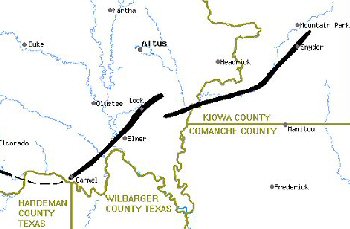
In its tract this side of the North Fork the tenant’s house on the McCowan ranch was destroyed and Ray Moss was killed. The father H. K. Moss had an arm broken and his wife, son Earnest, daughter Myrtle and a smaller daughter were all seriously injured, though it is hoped not fatal. The Johnson residence, Dr. McCoy’s, Frank Taylor’s houses and barns, Otter Creek School house, J. W. Blackmore’s and F. Engle’s houses and outbuildings were all destroyed. At the Engle house the monster again demanded human sacrifices to whet his appetite for the final feast at Snyder, and three of the family was killed and four injured. W. S. Russell’s unoccupied claim house was taken and the entire group of fine buildings on the Peckham ranch was made into kindling wood. . Then Jack Hunter’s house was destroyed and he and his wife and boy were all injured – his wife having since died. The Addison and the Lancaster houses joined the monster in its march on to Snyder. It’s tract through and the ravages of town were told of before. After leaving town it took the Andrews farm buildings, the Beardsley and Peyton buildings and some others further on which have not been reported at this office.
The names and losses of Snyder property owners cannot be given at this time as a complete list has not been made. This will be given in a later opine as will other detailed statements of work of the relief committee, etc. That all the killed and injured were so covered with black slime as to be unrecognizable was heretofore mentioned. This has been accounted for by the fact that the demon in crossing the river sucked up all the water in reach as well as Otter Creek and the ponds and lakes along the creek. To this water was added all the black slimy mud at the bottom of the ponds, scooping them out until nothing but hard ground was left. All this was spread out upon its Snyder victims giving them a most hideous and repulsive appearance.
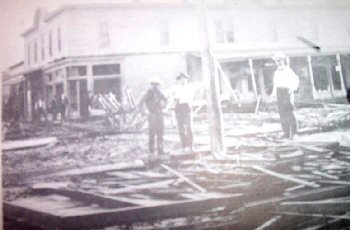
Posts standing to one side of the storm were driven full of straws and small stems of wood – just as if they were so many nails. In the southwest corner of the Signal-Star building a narrow piece of the thin end of a shingle was driven as if it was so much iron, and still remains there.
A heavy iron vault door frame weighing 2 or 3 thousand pounds was picked up and carried more than a block before it was dropped. An upright piano was found 8 miles from town sitting on a prairie in the same position as it was when picked up by the cyclone. The center of the storm passed across the railroad just between the old Midway restaurant and the Wagner Gin. This is demonstrated by the fact that an iron pump and pipe were lifted from the well. This could not hav occured except in the vacuum which is always in the center of such twisters.
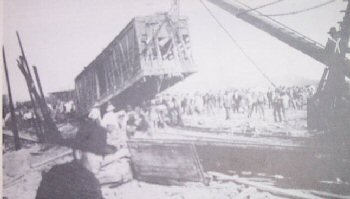
Those who were to one side, and in the position to see the storm, say it was like a huge snake hanging tail down from the clouds, wiggling along as it seeking to touch and fasten onto everything in its path. Pictures and papers thaat were in the wrecked houses have been picked up in Caddo County on the other side of Saddle Mountain 55 to 60 miles away. Many acts of heroism were enacted which will never be chronicled. One of the strongest was when Mrs. George W. Bailey, with compound fracture of ankle and bone protruding through the flesh, a fracture of one hip and filled with punctures made by slivers and nails, crawled to her husband's side, putting her knee against his back to assist her, pulled a piece of timber out of his back, which had been driven through him. When rescue came she begged them to care for her husband first.
The ghouls who robbed the dead and wounded did not get all the valuables. Miss Matilda Murphy had a little over $700.00 on her person when injured and Miss Iola Edwards wore a diamond ring. In Many instances, however, valuables were taken and in some, rings of very little value were taken. A small gold wedding ring which had nearly worn out was taken from the finger of Mrs. Coleman. The youngest baby in town was carried across the street and gently laid on the ground without even a scratch. Its father and mother, Floyd Hibbard and wife were more roughly used though not seriously injured.
Hundred of telegrams were received by the committee asking after people who were known to have been near Snyder. County Coroner Burke did noble work in caring for the dead. He took charge of the morgue and directed preparation of the bodies for burial. Through the liberal use of ice he was enabled to keep many bodies until their relatives arrived from distant points, for which he deserves the thanks of all.A. B. Seigal, who was in the telephone central office when the storm began, was pulled out of the door and carried two blocks to the southeast. He must have sailed in the air over the Signal-Star Building, but remembers nothing the time he was snatched from the door until some minutes after the storm when he answered the call made by the editor for parties whose houses had been destroyed in the vicinity. Seigal then talked and acted as if very much dazed. Two whole families were snuffed out of existence - the Fessenden and G. C. Jones families. Of the Hibbard family but one boy was left. (Note: Two Hibbard sons lived, Lloyd and Ed, from Mrs. (Chuck)Ginny Hibbard, daughter-in-law of one of the surviving sons.)
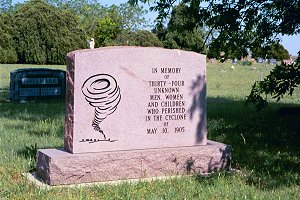
J. W. McCart will live, but he is minus an arm. At this writing, Matilda Murphy is still living but no hopes are entertained for her recovery. The surgeons had to amputate a foot. Miss Alice Dunn is making a brave fight for life.Her sweet uncomplaining disposition has endeared her to all hospital attendents. (Note: Miss Dunn had to have bones re-broken later on to re-set.) The marshall of Anadarko with a party of gentlemen were modestly at work on our streets for two days. They came and went unheralded and none would have known who they were had they not been recognized by one of our prominate citizens.
Many men who came from other towns seeing our needs worked on our streets like common laborers through (illegible). They worked when work was needed, as well as contributing liberally to the relief fund. Those were brave men. A round silver tray on which was inscribed "George and Mary - Silver Wedding 1870" was picked up several miles in the country, somewhat twisted and banged up. Soon after the supplies were being received a thieving skunk presented hinself at the quartermaster's dept., representing that he was a cyclone sufferer. He was outfitted with everything he wanted, but before he got out of town with the stuff, someone reported him and brought him back and made him disgorge.
Mr. Snyder, the gentleman enstalled as depot agent in place of Mr. Egan, who was hurt in the cyclone, is a very pleasant and accomodating gentleman. He and his assistants have been of incalculable service to the Relief Committee.
~*~*~*~*~*~*~*~*~*~*~*~*~*~*~*~*~*~
This date, May 10, 2005 is the 100th anniversary if this devastating tornado. The folks that lived through this, as well as the signs of the destruction, are now gone. Snyder still exists and life goes on.
It was impossible to estimate the money loss from the tornado but it was estimated, when all details are in, that it would reach about $400,000.00.
A partial list of businesses destroyed or damaged
| Compress..............................................$20,000.00 Gin........................................................$20,000.00 Roundhouse...........................................$30,000.00 Gin.........................................................$12,000.00 Freight and Depot...................................$15,000.00 Ranch house and barn of Ed. L. Peckham, largest and finest in the territory...............$40,000.00 Midland Hotel.........................................$ 5,000.00 22 other business houses and stocks of goods..................................................$50.000.00 95 residences...........................................$75,000.00 |
Judge Allison, editor of the Signal-Star barely escaped with his family. He turned his house into a hospital.
The big wall clock of the jeweler occuping space in the Eagle drug store stopped at exactly 8:43, pinpointing the time the tornado struck
Hobart donated money and sent over 200 people, physicians, surgeons, nurses and helpers..
More information on the Snyder tornado can be seen on the National Weather Service site in Norman OK.
Return to Snyder Tornado Intro
*~*~*~*~*~~*~*~*~*~*~*~*~*~*~*~*~*~
Photos on this page were sent to me by various sources, among them are Mrs. Chuck (Ginny) Hibbard. The map of the tornado path courtesy National Weather Service, Norman OK, other photos courtesy Western Heritage Collection Oklahoma University.